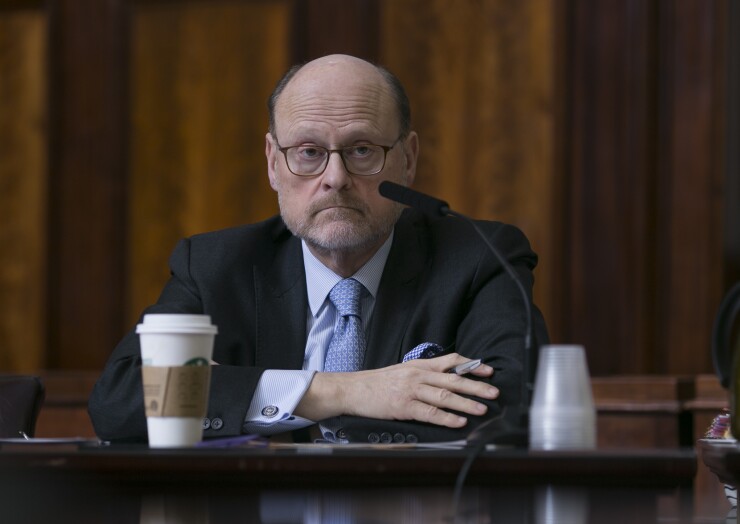New York’s Metropolitan Transportation Authority is no longer a double-A credit, according to S&P Global Ratings.
The rating agency Monday downgraded the MTA to A-plus from AA-minus, citing a spike in operating expenses and debt service requirements without matching revenue growth at the state-run authority, which operates New York City's mass transit system. The outlook is negative.

Signal malfunctions, breakdowns and delays on the subways and buses have triggered discussions about the authority's debt and lack of a recurring revenue stream.
The MTA is one of the largest municipal issuers with roughly $38 billion in debt. Gov. Andrew Cuomo declared a state of emergency last June.
"The lowered ratings reflect our assessment of MTA's most recent estimates and forecasts and our calculation of potentially inadequate consolidated net debt service coverage for unaudited fiscal 2017, budgeted fiscal 2018, and forecast 2019, given rising operating expenses and debt service requirements without corresponding growth in gross revenues," said S&P analyst Paul Dyson.
In conjunction with the downgrade to the MTA's issuer rating, S&P also lowered its long-term rating and underlying rating on the MTA's revenue bonds to A-plus from AA-minus. At the same time, S&P affirmed its SP-1-plus short-term rating on the district's previously issued transportation revenue bond anticipation notes.
“The MTA’s bond ratings remain extremely strong and we’re grateful that S&P continues to recognize our ‘very strong management and governance policies, with very strong financial policies,’" said spokesman Aaron Donovan. "S&P’s action recognizes the MTA’s stated need that additional recurring revenue is necessary to support operations and debt funded capital investment. Meanwhile, we have undertaken aggressive cost control measures and we are focused on reducing construction costs and reforming our procurement processes.”
S&P's downgrade brings its rating of MTA in line with the A1 of Moody's Investors Service. Fitch Ratings assigns its AA-minus rating to the MTA's workhorse revenue bond credit, and Kroll Bond Rating Agency rates them AA-plus.
S&P also assigned its SP-1-plus short-term rating to the MTA's proposed $400 million series 2018B transportation revenue bond anticipation notes. At the same time, it assigned its A-plus long-term rating, with a negative outlook, to the authority’s $100 million remarketed series 2002D-2b transportation revenue variable rate refunding bonds – London Interbank Offered Rate floating rate tender notes, which the MTA intends to remarket March 20.
Moody's Investors Service determined that the remarketing per se will have no underlying rating impact on the bonds. Moody's now rates the bonds A1 with a stable outlook.
The series 2018B BANs proceeds will finance existing approved transit and commuter projects.
S&P pegged the MTA’s all-in consolidated net revenue debt service coverage as “only adequate” at 1.23 times in fiscal 2016, down from 1.45 times the previous year, with indications that coverage for fiscal 2017 through 2019 could be less than 1 times.

S&P also cited continuing pressures to maintain a structural balance, with projected operating deficits of $403 million and $602 million in fiscal 2020 and 2021, respectively, while noting that management has traditionally closed operating deficits to obtain a near-term structural balance. S&P added expects the MTA’s “very high” debt burden will continue as a result of significant capital needs.
The authority 2015-2019 capital program amounts to $32.5 billion, of which about $3 billion is self-funded through bridge and toll revenue. The city, under a deal that Cuomo brokered, is contributing $2.5 billion to that plan.
S&P said it could revise the outlook to stable within two years if the authority's debt service coverage stabilizes and it manages its “significant and growing capital needs and debt plans.” S&P said it could lower the rating in that time, possibly by multiple notches, if coverage falls to or near the inadequate levels forecast, ridership falls and stays materially short of forecasts, or liquidity decreases materially.
MTA Chairman Joe Lhota last week appeared before the City Council asking the city to contribute half of the estimated $836 million he deemed necessary to backstop the first phase of a subway triage plan.
Mayor Bill de Blasio has resisted, saying the MTA is a state agency and Albany should replenish the roughly $400 million it has taken from dedicated transit accounts to balance the state’s general fund. But City Council Speaker Corey Johnson has been receptive to adding funds for transit in exchange for stringent city oversight.
De Blasio’s $88.7 billion preliminary budget is before the council. The mayor will then submit his executive budget, which the 51-member council must approve by June 30.
City-state politics have ensnared the MTA since its origination in the late 1960s. A running feud between Cuomo and de Blasio has intensified the rift.
“More fundamentally, the disagreement is over which level of government is ultimately responsible for the system’s performance,” said the
Cuomo’s executive budget legislation includes a proposed amendment to the state’s public authorities law that would require spending by the city to match any state spending whenever an emergency is declared relating “to the continuing failures and the condition of the track, signals and other infrastructure…” of New York City Transit, the MTA unit that oversees subways and buses.
The city would have 60 days to match state appropriations. “In the case of the stabilization plan put forward last summer, the city would have been required to appropriate over $400 million in unanticipated spending,” said IBO.





